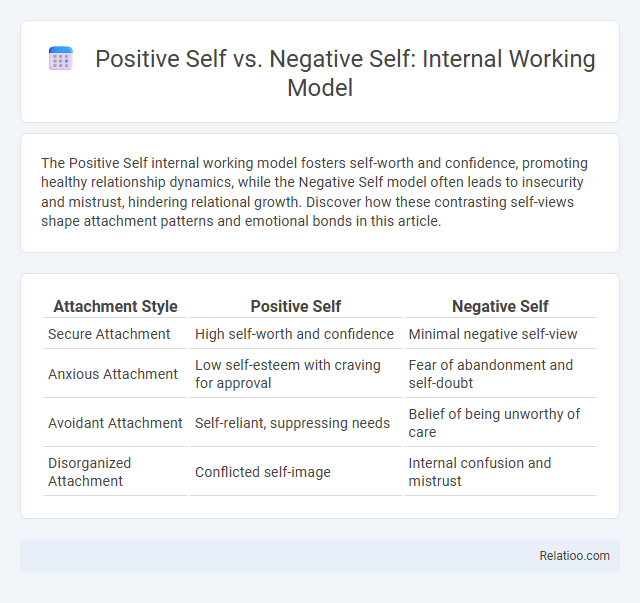The Positive Self internal working model fosters self-worth and confidence, promoting healthy relationship dynamics, while the Negative Self model often leads to insecurity and mistrust, hindering relational growth. Discover how these contrasting self-views shape attachment patterns and emotional bonds in this article.
Table of Comparison
| Attachment Style | Positive Self | Negative Self |
|---|---|---|
| Secure Attachment | High self-worth and confidence | Minimal negative self-view |
| Anxious Attachment | Low self-esteem with craving for approval | Fear of abandonment and self-doubt |
| Avoidant Attachment | Self-reliant, suppressing needs | Belief of being unworthy of care |
| Disorganized Attachment | Conflicted self-image | Internal confusion and mistrust |
Understanding Internal Working Models
Internal working models are mental representations of the self, others, and relationships, shaping expectations and behaviors in social contexts. Positive self-internal working models reflect a secure sense of worth and trust, leading to healthy attachments and adaptive interpersonal interactions. Negative self-internal working models involve feelings of unworthiness or mistrust, contributing to insecure attachments and challenges in emotional regulation and relationship stability.
Defining the Positive Self Internal Working Model
The Positive Self Internal Working Model refers to an individual's mental framework in which the self is perceived as worthy, competent, and lovable, fostering secure attachment and healthy emotional regulation. This model influences expectations in relationships, promoting trust and resilience, contrasting with the Negative Self Internal Working Model, which involves feelings of unworthiness and insecurity. Understanding the Positive Self Internal Working Model is crucial in attachment theory and psychological development, as it shapes self-esteem and interpersonal dynamics.
Defining the Negative Self Internal Working Model
The Negative Self Internal Working Model refers to the mental framework where individuals perceive themselves as unworthy, unlovable, or inadequate, significantly shaping their thoughts, emotions, and behaviors in relationships. This internalized belief system often results from early adverse experiences and influences how Your self-esteem and attachment patterns develop over time. Understanding this model is crucial for addressing negative self-concepts and fostering healthier interpersonal connections.
Origins of Self-Perception: Early Attachment Influences
The origins of self-perception are deeply rooted in early attachment experiences, where the internal working model forms as a mental representation of the self and others. Positive self-internal working models arise from secure attachments, leading to healthy self-esteem and adaptive relational patterns. Conversely, negative self-internal working models, shaped by inconsistent or neglectful caregiving, result in low self-worth and maladaptive interpersonal dynamics.
Characteristics of a Positive Self Image
A Positive Self Image, central to the Internal Working Model, is characterized by self-confidence, resilience, and realistic self-assessment, enabling you to navigate challenges effectively. It contrasts with a Negative Self Image, which often includes self-doubt, vulnerability to stress, and distorted perceptions of worth. Your internal working model shapes relationships and emotional regulation, making a positive self-view essential for mental well-being and adaptive interpersonal interactions.
Features of a Negative Self Schema
A Negative Self Schema in the Internal Working Model is characterized by persistent feelings of unworthiness, self-doubt, and a tendency to interpret experiences through a lens of inadequacy or failure. Your Negative Self often leads to avoidance of intimacy, fear of rejection, and difficulty trusting others due to an internalized belief that you are undeserving of love and support. This internal framework shapes perceptions, emotions, and behaviors, reinforcing negative patterns that hinder personal growth and healthy relationships.
Impacts on Emotional Well-Being and Relationships
Positive self internal working models foster healthy emotional well-being by promoting self-worth and resilience, enhancing your ability to form secure, trusting relationships. Negative self internal working models often lead to emotional distress, anxiety, and difficulties in maintaining close connections due to fears of rejection or inadequacy. Understanding these internal working models is essential for improving emotional regulation and developing healthier interpersonal dynamics.
Strategies to Shift from Negative to Positive Self Models
Shifting from a negative to a positive self internal working model involves consistent cognitive restructuring, emphasizing self-compassion and reframing limiting beliefs into empowering narratives. Employing mindfulness techniques enhances awareness of automatic negative thoughts, enabling deliberate activation of positive self-schemas linked to secure attachment patterns. Integrating therapeutic strategies such as cognitive-behavioral therapy (CBT) and attachment-based interventions strengthens adaptive self-representations and fosters resilience in interpersonal relationships.
The Role of Therapy in Reshaping Internal Working Models
Therapy plays a critical role in reshaping internal working models by helping individuals identify and challenge negative self-perceptions embedded in their negative self internal working model. Through cognitive-behavioral techniques and attachment-focused interventions, therapy fosters the development of a positive self internal working model, promoting healthier relationships and improved emotional regulation. By addressing maladaptive schemas and reinforcing positive self-beliefs, therapeutic processes facilitate lasting changes in internal representations of self and others.
Fostering Lasting Positive Self-Beliefs
The Positive Self internal working model shapes your interactions by fostering lasting positive self-beliefs that enhance resilience and emotional well-being. Negative Self internal working models often lead to persistent self-doubt, impacting your confidence and relationships negatively. Understanding and restructuring these internal working models can cultivate a stable and affirming sense of self, promoting mental health and personal growth.

Infographic: Positive Self vs Negative Self Internal Working Model
 relatioo.com
relatioo.com